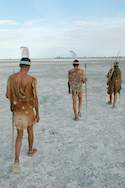Bushmen Cousins

After the Bushmen, came the Khoikhoi (also called Khoekhoe, Khoenkhoen or Koina).
They were close cousins of the Bushmen, but had started keeping flocks of cattle and sheep.
This type of stock farming with domesticated animals began in the Middle East around 10000 years ago and slowly spread down the African continent, as receptive local tribes picked up the practice.
Then, about 2000 years ago, these Khoikhoi people took their herds and moved South from Northern Botswana into South Africa.
They passed through the Bushman’s realm without stopping, and headed on into the South and West.
Here they chose to settle, spreading out along the Southern Cape coast from East London to Cape Town, as well as in Namaqualand – a region still named after the Nama clan of the Khoikhoi.
Cattle and sheep were very important to the Khoikhoi. Their flocks gave them stability, status and security. More fundamentally, a regular supply of meat and milk greatly reduced all that inconvenient hunting and gathering, and it certainly added fuel to their physicality. For the Khoikhoi, cows had become a currency with legs.
The Bushmen, for their part, didn’t really mind the implied criticism. They may have got a little annoyed when the Khoikhoi herds got in the way of their traditional hunting routes and the Khoikhoi, in turn, might have been miffed when the Bushmen got in the way of their herds.
But there was still plenty of land to go around and, by some kind of general agreement, the Bushmen focussed their attention on the Natal side of the country while the Khoikhoi gravitated towards the Cape.
Khoikhoi’s Unhappy Fate
Once they had settled down, the Khoikhoi organised themselves into an extended clan structure, headed by chieftains. There were the Cochoqua and Guriqua in the North, the Chainouqua, Hessequa, Gouriqua, Attaqua and Houteniqua in the East, the Namaqua in the North, and the Goringhaiqua, Gorachouqua and Goringhaikona around the Cape Peninsula.
By all accounts, these different tribal groups spent many happy centuries tending their herds and extending their families, with only the occasional feud between the chiefs to keep things exciting. But the Khoikhoi’s fate was not to be a happy one.
They were the people destined to endure the first convulsive meetings with the Europeans, who had started landing at the Cape from 1500 onwards, and they were also the first indigenous nation to allow the yoke of white supremacy to be placed around their necks.
A Good Judge of Character
Almost from the first, the Europeans viewed the ‘Hottentots’ with ill-concealed disgust. The whites didn’t approve of the Khoikhoi’s facial features, their temperament, their dangling anatomy, their lack of clothing or their perceived dishonesty.
They found the Khoikhoi habit of smearing rancid animal fat all over their bodies particularly abhorrent (despite the quite logical explanation that the stinking grease helped ward off fleas), and the Dutch were often tempted to shoot the whole bloody lot of them and be done with it.
On the other side of the fence, the Khoikhoi thought the Europeans were foolish, foppish and arrogant. They hated the way the Europeans swanned around the Cape like they owned the place, and resented the ‘cultivated’ European attitude that held the Khoikhoi up as nothing more than filthy, Godless savages.
Most of all, they were afraid that the Europeans would steal their land, plunder their herds and chase the Khoikhoi away from their homes. It sounds like the Khoikhoi were pretty good judges of character.
Smallpox Rescues the Europeans
So, predictably, the Europeans and the Khoikhoi did not get on. It was a volatile mixture of personalities that was bound to explode, sooner or later.
And so it was, only a few decades after first meeting the white man, that incipient Khoikhoi nationalism resulted in several inglorious battles between the Dutch and the Khoikhoi. In the late 1600s and early 1700s, this popular wave of resistance was gathering momentum, as the Khoikhoi became increasingly outraged by the ever-more emphatic control exerted by the illegitimate colonial authorities at the Cape.
But it all started to come undone when the smallpox epidemic of 1713 decimated the Khoikhoi nation and destroyed their traditional family structures.
Several other outbreaks, most notably in 1755 and 1767, compounded the tragedy and, once they had been wholly suppressed by force, disease and liquor, the Khoikhoi were doomed to become the white man’s servant; gradually assimilating into the fabric of South African society and finally trickling away into cultural extinction.
 At first, there was very little European interest in the Cape of Storms. The waters around the headland were turbulent and so were the nativ...
At first, there was very little European interest in the Cape of Storms. The waters around the headland were turbulent and so were the nativ... As time went by in die 1600’s, illegal trade with the Khoikhoi became a popular way of making a few extra guilders for the Free Burghers, ...
As time went by in die 1600’s, illegal trade with the Khoikhoi became a popular way of making a few extra guilders for the Free Burghers, ...